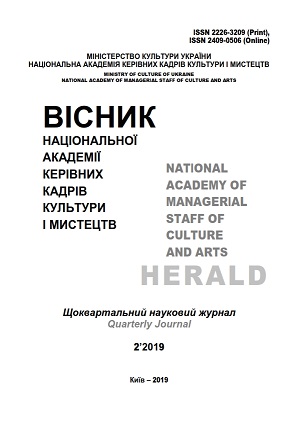Імпровізація в хореографії: поліаспектність проявів
Improvisation in Choreography: Polyaspectivity of Manifestations
Author(s): Volodymyr Anatoliyovych GrekSubject(s): Theatre, Dance, Performing Arts, Sociology of Art
Published by: Національна академія керівних кадрів культури і мистецтв
Keywords: improvisation; choreography; contact improvisation; modern dance;
Summary/Abstract: Purpose of Research is to identify the main aspects of the use of improvisation in modern choreography. Methodology. Analysis of the literature and sources contributed to the identification of unexplored aspects of improvisation in choreography; the historical principle made it possible to trace the transformation of approaches to improvisation at different stages of the development of modern choreography in chronological order. Scientific novelty. The scientific novelty consists in identifying the main aspects of the use of improvisation in modern choreography. Conclusions. Improvisation can be present in any type of choreography as a free “here and now” expression of its internal (physical, psycho-emotional, spiritual, etc.) impulses in accordance with music, time, space, and the like. Improvisation in modern choreography exists in a wide range of manifestations – from mastery of mastering the worked-out elements in accordance with the proposed circumstances to body-emotional self-expression free from canons outside standardized forms, where listening to the inner self exclusively dominates. Based on the experience of previous periods in the development of modern choreography, the dance practice of the present uses improvisation in several aspects: as a peculiar source of new movements, a method of laboratory work on the search for new lexical structures for further use in the formulation of stage dance forms; as a way of psycho-emotional normalization, the study of their own bodily and psycho-emotional potential; additionally in contact improvisation – as the ability to “feel” a partner, a means of improving the technique of duet and group interaction. We consider disclosure of the role of improvisation in choreographic education of children of different ages, art history analysis of choreographic forms where improvisation is used, and so on, are important areas for further research.
Journal: Вісник Національної академії керівних кадрів культури і мистецтв
- Issue Year: 2019
- Issue No: 2
- Page Range: 463-466
- Page Count: 4
- Language: Ukrainian

